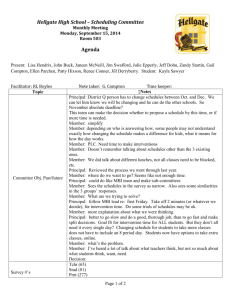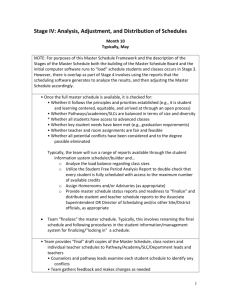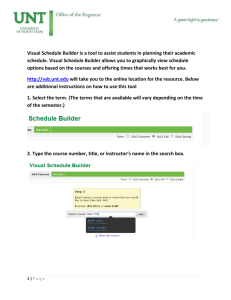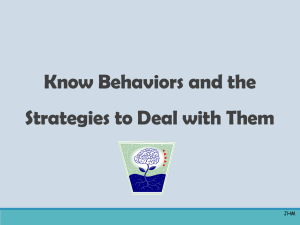Project Management
advertisement
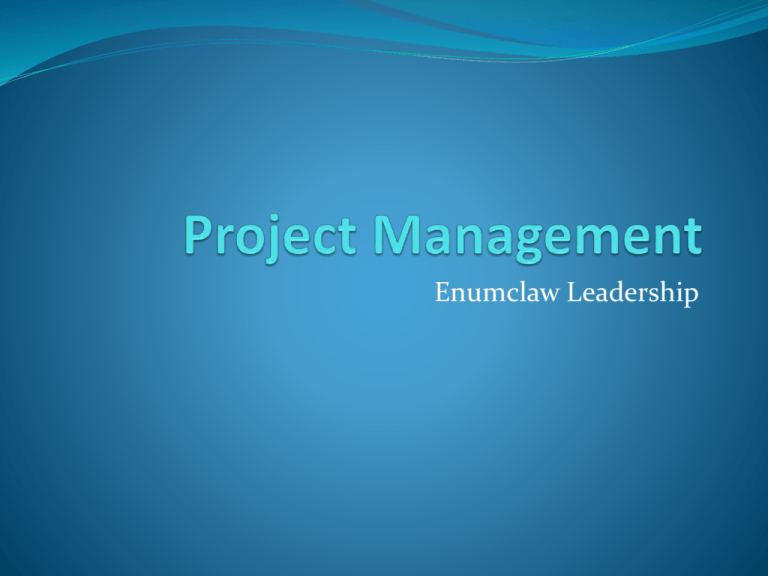
Enumclaw Leadership Making Schedules Schedules: Purpose One The first is to make commitments about when things will be done. Its almost a contract between the members of the work team. In business, they are used externally to close a deal. Often a customer is paying for a timeline (thing Fed Ex. Or UPS) Schedules: Purpose Two Encourage everyone who’s contributing to a project to see their efforts as part of a whole. Until there is a draft schedule suggesting specific dates and times for when things will be done, its unlikely that connections and dependencies across teams will be scrutinized. Psychological power in a schedule that externalizes and amplifies the commitment that is being made. Forcing Function Psychological or pressure shift. Naturally forces a change in perspective, attitude, or behavior. Schedules: Third Purpose Tool to track progress and break work into manageable chucks. Breaking things down into one or two day sizes actually helps people understand what the work is that they need to do. House in 120 days??? Size of Project The larger and more complex a project, the more important a schedule becomes. First game is September 4th. Three weeks of practice Offense, defense, kicking Who starts, second team Game situational prep Rule of Thirds Design – figuring out what should be done. Planning the assembly or dance. Implementing – actually doing it. Testing – analyzing. Divide and Conquer One big project means many little schedules. Phase One Phase Two Phase Three Design Design Design Implementation Implementation Implementation Testing Testing Testing Estimates All estimates are probabilities. A detailed and thorough analysis can yield 90% Press people on estimating with confidence. Estimates depend on the understanding of the projects goals. Previous performance Sophomore Class Game Night Date: May 20th Team members: Brooke, Bailey, Zoey, Keelie, Jake, Isaiah, and Ariel. Vision: To create an activity to raise money for the sophomore class. Goal 1: raise $500.00 Goal 2: Goal 3: Special Needs Bracelet Project Date: ongoing Team members: Ariely and Jamie Vision: To raise money and exposure for the high needs students at Enumclaw. Goal 1: To raise $_______ Goal 2: To provide opportunities for these students to run a business on campus. Goal 3: to provide a community service project. Sock and Clothing Drive Date: May 11th – 14th Team members: Rechelle, Seth, Morgan, Savannah, Lauren, Eric, Trent, Peyton Vision: To raise $500.00 to donate to global cause. Goal 1: Goal 2: Goal 3: Senior Class Talent Show Date: April 16th Team members: Katie, Rob, Alyssa, Keyla Vision: To create a talent show which will raise $500.00 for the Senior Class Goal 1: Goal 2: Roadside Litter Project Date: May 2nd Team members: Nikole, Taylor, Griffin, Sam, and Carson Vision: successfully clean Veasey Cumberland Highway assigned to EHS. Goal 1: Goal 2: Assignment #1 Using Friday’s assignment as a starting point, brainstorm all tasks that need to be completed to reach your goals. Group all the activities into categories. Assign team members to activity groups. Produce a wall chart showing tasks, names, completion dates. What Must Happen for Schedules to Work? Milestone length should match project volatility. Be optimistic in the vision and skeptical in the schedule. (Murphy's Law when the computer locks up) Plan checkpoints for add/cut discussions. Gauge the team’s experience with the problem space. Sam’s experience planning assemblies. Project Planning What is it we need to do? This is usually called requirements gathering. How will we do it? Designing or specifying. Go slow to go fast Abe Lincoln said, if I had six hours to cut down a tree, I’d spend four hours sharpening the axe and two hours cutting down the tree. Plans and Perspectives Business perspective includes profit, sales, expenses, competition and costs. Who is the customer and what do they want? Technology perspective focuses on how things are built and how they will work. Customer perspective is the most important of the three. What do the students want in an assembly? Student body perspective Leadership perspective Faculty perspective Asking the Right Questions What does the Enumclaw community want in an assembly? Do we have the technology to satisfy the needs of our customers? Screens, cordless mics. Computers. How do we prepare and practice without missing classes? Common Bad Ways to Decide Bad Way Example Why Problem Do it like last time This assembly will be like last years Not the desire to go back and do new research School expects more. People get excited about trends b/c they are fun to follow. Customer requirement should trump fads. We will build what We will use the is hot and trendy newest Disney Movie If we build it, they will come. Assembly X will be By distracting the best ever everyone to the building, they forget the reason for building. Does the world need a better mousetrap? Kids will come b/c it was cool. The Daily Work The most important part of the process is the roles that people are expected to play Everyone should know what the milestones reports, presentations, documents are. There should be frequent meetings where each perspective is discussed. Planning Involves The most powerful way to plan a project involves three equal perspectives: student body, leadership, and adults. Creating a Vision Vision The value of writing things down like to recipe for that cake. What all are doing What some are doing What I’m doing Vision, goals A strong vision statement of the assembly: The spring sports pep assembly will recognize all athletes while entertaining the student-body and faculty. Can the vision be drawn? Goals: students would still attend if they were not required to go. Where Ideas Come From Outside the box thinking. Tools for Ideas T Chart affinity Pareto Venn Using a Pareto Chart in Planning Suggestions to improve assemblies from BOC meetings. Rank them in order Place on a bar chart from most to least Ideas Following brainstorming look for ways to group ideas into like categories. Three to five alternatives. Two choices investigate, research, prototype, and question. One design investigate, research, prototype, and question the final choice. Specifications Requirements we must live up to. Feature. A feature specification describes the what the customer receives from our product. Work breakdown structure which is all the small details. Ex. Write the request to purchase, Natasha types up PO, Natasha sends to Tim at district, Tim assigns a # and returns, we can order. ASB Processes Purchase Order Process Facilities Process Promotion Process Security Process Staff Communication Process Communication Projects are only as good as people on the team. How to facilitate meetings. Direct conversation End the conversation Make history Meetings Facilitator’s role Are the right people in the room? Sit or stand Prepare Gadgets Being on time End with clear steps and owners How to Make Things Happen Priorities make things happen. Common ordered lists Project Management the most common types of ordered lists are project goals, features, and work items. Know the Critical Path The shortest sequence of work that can complete the project. Diagram or flow chart. Show where bottlenecks will be If features A, B, and C are can’t be completed until D is done, D must be on the critical path. Emotional Toolkit Pressure: a compelling, constraining influence or force. A constraint can’t be moved. The assembly is this day. Stephen Covey’s 4 quadrants The Four Colors Put the right people on the bus and get them in the correct seat. The Middle Game Strategy Tactical (daily) questions. Looking at the goals everyday. Is what your doing today contributing to the big picture? Weekly questions What’s the probability for hitting target? What adjustments End Game Strategy Big deadlines are a set of small deadlines. Define exit criteria at the beginning. The end-of-game is a slow, mind-numbing process. The challenge is to narrow the scope of changes until a satisfactory release remains. Evaluate what worked, what didn’t and what to change.
